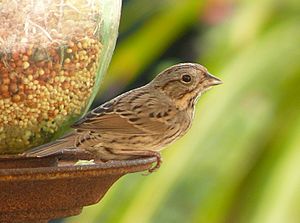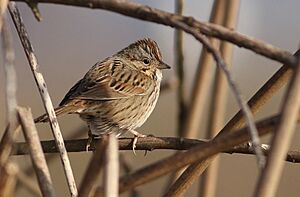Lincoln's sparrow facts for kids
Quick facts for kids Lincoln's sparrow |
|
|---|---|
 |
|
| Conservation status | |
| Scientific classification | |
| Genus: |
Melospiza
|
| Species: |
lincolnii
|
 |
|
The Lincoln's sparrow (Melospiza lincolnii) is a small bird found in North America. It's a type of American sparrow. This bird often hides in thick bushes and plants. You might not see it easily. But you can recognize it by its sweet, gurgling song. It sounds a bit like a wren.
The Lincoln's sparrow is one of three species in the Melospiza group. The other two are the song sparrow and the swamp sparrow. Lincoln's sparrows like to live in bushy areas, often close to water. Scientists don't know a lot about this bird. This is because it's very secretive and breeds in hard-to-reach northern areas.
Contents
What Does the Lincoln's Sparrow Look Like?
Adult Lincoln's sparrows have dark streaks on their olive-brown backs. Their chest is light brown with fine streaks. Their belly and throat are white. They have a brown cap with a grey stripe in the middle. Their wings are olive-brown, and their tail is narrow.
Their face is grey with brown cheeks. They have a buffy (light yellowish-brown) "mustache" stripe. A brown line goes through their eye, with a thin ring around it. Male and female Lincoln's sparrows look the same. They look a bit like the song sparrow. However, Lincoln's sparrows are smaller and thinner. Their chest streaks are also finer.
Young Lincoln's sparrows look a lot like young swamp sparrows. They have a streaky chest. But Lincoln's sparrows rarely have a solid-colored crown like the swamp sparrow.
How big are adult Lincoln's sparrows?
- Length: About 5.1 to 5.9 inches (13 to 15 cm)
- Weight: About 0.6 to 0.7 ounces (17 to 19 grams)
- Wingspan: About 7.5 to 8.7 inches (19 to 22 cm)
Naming the Lincoln's Sparrow
The Lincoln's sparrow was named by a famous bird artist, John James Audubon. He named it after his friend, Thomas Lincoln. In 1834, Lincoln shot the bird during a trip with Audubon to Nova Scotia. Audubon decided to name the bird to honor his travel buddy.
Types of Lincoln's Sparrows
There are three known types, or subspecies, of Lincoln's sparrow. Some experts think two of them, M. l. lincolnii and M. l. alticola, might be the same. This is because they look very similar.
- M. l. lincolnii is usually larger. It has more reddish-brown or grey-brown colors. Its back feathers have less yellow on the edges.
- M. l. gracilis is smaller. It has more yellow on its back feathers. It also has wider dark streaks, which make the colors on its back stand out more. This type breeds from southern Alaska to central British Columbia.
- M. l. alticola, also called the Montane Lincoln's Sparrow, is the biggest type. Its color is more even, with a mostly brown back. It has narrow streaks on its back feathers. It lives in the central Rocky Mountains in Canada. It also lives in the mountains of California and Oregon. It breeds as far south as New Mexico and Arizona.
Where Lincoln's Sparrows Live
Lincoln's sparrows breed in high-altitude areas across Canada, Alaska, and parts of the northeastern and western United States. They are less common in the eastern parts of their range. They mostly live in wet, thick bushes, bogs (wetlands), and mossy places. They like dense shrub cover. Their nests are well-hidden, shallow cups on the ground under plants. In lower areas, they can also be found in mixed forests with deciduous trees (trees that lose leaves). They also live in areas with willows and black spruce-tamarack bogs. They usually look for food on the ground or at the base of willow trees. They use tall trees and willow branches for singing.
During their migration, they live in thickets and bushes. They especially like areas near rivers and streams, called riparian zones. They use lowlands like the Great Plains and Great Basin. They can also be found in towns and suburbs in the east. Their migration starts between May 13th and 30th. It lasts until August 20th to September 20th. In winter, they live in southern areas. These include tropical evergreen and deciduous forests. They also live in dry and wet pine-oak forests, Pacific swamp forests, and dry subtropical scrublands.
Their winter homes stretch from the southern United States down to Mexico and northern Central America. They are passage migrants (birds that pass through) in most of the United States, except in the west. In 2010, a Lincoln's sparrow was seen for the first time in the Dominican Republic. They have also been seen in mountain areas of Haiti. It's hard to know their full range. This is because they hide a lot and prefer dense habitats.
Lincoln's Sparrow Behavior
Vocalizations (Sounds)
The Lincoln's sparrow is a very shy bird. You might not see or hear them, even where many live. Only the males sing. Their song is special among the Melospiza group. They make a sweet, gurgling song with different notes. It often starts with several fast, high-pitched notes. Then it goes into a trill (a rapid repeating sound) that starts low, rises quickly, and then drops.
Like the swamp sparrow, the Lincoln's sparrow doesn't have many different songs. Each bird sings about 3 or 4 different types of songs. However, their song is complex, with many syllables. This is similar to a song sparrow's song. The swamp sparrow, in contrast, has a simple, single-syllable song. Lincoln's sparrows sing most often in the morning. They only sing at the start of the breeding season, before the female lays eggs. They often sing while sitting on open branches or while flying.
This bird has two main calls:
- One is a sharp, flat tup or chip sound. This is used when they are aggressive.
- The other is a soft, high-pitched buzzing zeet sound. Males often follow this call with their song. The zeet call is usually used when they are hidden in thick cover. The chip call is used when they are out in the open. It can attract attention or be used during fights. Both calls are used to defend their nest.
They also have a distinct, hoarse, buzzing zrrr-zrrr-zrrr call. They use this call for mating, during fights over territory, and when guarding their mate.
What Lincoln's Sparrows Eat
In winter, Lincoln's sparrows mostly eat small seeds from weeds and grasses. If they can find them, they will also eat small vertebrates (animals with backbones). During the breeding season, they mainly eat arthropods. These include insect larvae, ants, spiders, beetles, flies, moths, caterpillars, and mayflies. Adult sparrows usually eat spiders and other prey higher up the food chain. But they feed their chicks more plant material and smaller prey like grasshoppers.
They mostly look for food on the ground in dense plants. In winter, they might visit bird feeders. They catch prey with their beak while hopping on the ground. They usually swallow their prey whole.
Reproduction and Life Cycle
Male Lincoln's sparrows arrive at the breeding grounds in mid to late May. They start singing to attract a mate. In early June, females build their nests. Nests are on the ground under thick grass or bushes. They are often inside a low willow shrub or mountain birch. Sometimes they are in a dip in sphagnum moss. The nest is a well-hidden, shallow cup made of grasses or sedges.
A female usually lays 3 to 5 eggs. The eggs are oval and pale green to greenish-white. They have reddish-brown spots. One egg is laid each day. Females start sitting on the eggs (incubating) before all the eggs are laid. Males do not help with incubation. Incubation lasts about 12 to 14 days.
Young birds are born helpless (called altricial). They leave the nest about 9 to 12 days after hatching. Their parents might still care for them for another 2 to 3 weeks. Young birds can barely fly on their first day out of the nest. But their flying skills get better quickly. By day six, they can fly more than 10 meters (about 33 feet) at a time.
For male Lincoln's sparrows, the shape of their beak is linked to how good their songs are. If their beak is less tall compared to its width, their song quality goes down. This matters for how successful they are at having babies. Females prefer males with better songs. Males that hatch later in the breeding season often have beak shapes that are not as good for singing. This means they are less likely to attract females and have young.
Images for kids
See also
 In Spanish: Gorrión de Lincoln para niños
In Spanish: Gorrión de Lincoln para niños





